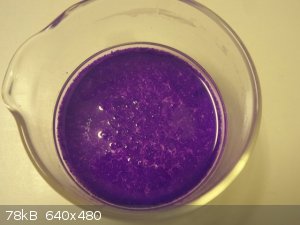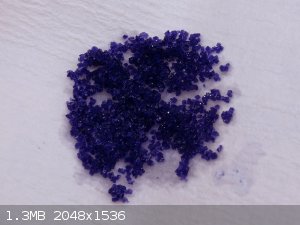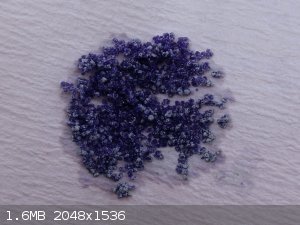| Pages:
1
..
6
7
8
9
10
..
14 |
artemov
Hazard to Others
  
Posts: 181
Registered: 22-8-2018
Member Is Offline
|
|
Why do you not like this? I use 60% H2SO4 when distilling HCl and low boiling alcohols. I hope I'm not doing things wrong ...
|
|
|
Sulaiman
International Hazard
    
Posts: 3695
Registered: 8-2-2015
Location: 3rd rock from the sun
Member Is Offline
|
|
nothing wrong, its just me, so that I do not forget an get it on me ... trivial really.
CAUTION : Hobby Chemist, not Professional or even Amateur
|
|
|
Bezaleel
Hazard to Others
  
Posts: 444
Registered: 28-2-2009
Member Is Offline
Mood: transitional
|
|
Made some Ni(en)3I2. Dissolved this in dilute KI to recrystallise.

|
|
|
mayko
International Hazard
    
Posts: 1218
Registered: 17-1-2013
Location: Carrboro, NC
Member Is Offline
Mood: anomalous (Euclid class)
|
|
I've been trying to extract ibuprofen from OTC pills. should be a simple base/acid extraction, but the filler made the first extraction completely
insoluble and when I tried to recrystallize the acid precipitate from IPA, it has instead formed an oily bilayer. What a mess.
al-khemie is not a terrorist organization
"Chemicals, chemicals... I need chemicals!" - George Hayduke
"Wubbalubba dub-dub!" - Rick Sanchez
|
|
|
MidLifeChemist
Hazard to Others
  
Posts: 192
Registered: 4-7-2019
Location: West Coast USA
Member Is Offline
Mood: precipitatory
|
|
Did you do that to reduce the solubility via the common ion effect?
|
|
|
Bezaleel
Hazard to Others
  
Posts: 444
Registered: 28-2-2009
Member Is Offline
Mood: transitional
|
|
No, it's just a final purification step,
to get rid of assumed co-crystallised chloride.
|
|
|
MidLifeChemist
Hazard to Others
  
Posts: 192
Registered: 4-7-2019
Location: West Coast USA
Member Is Offline
Mood: precipitatory
|
|
Got it - ok I'm assuming the idea is that the iodide ions from the KI will replace the chloride ions. So why do you need to do this second step - to
get the Ni(en)3I2 the first time, did you simply boil away or evaporate the solution, is that why you need to recrystallize? And how do you know this
is the iodide and not the chloride? I couldn't find any references to Tris(ethylenediamine) nickel (II) iodide or to its solubility. It looks like an
interesting compound that I may want to try to make one day. Thanks in advance for the info!
|
|
|
Bezaleel
Hazard to Others
  
Posts: 444
Registered: 28-2-2009
Member Is Offline
Mood: transitional
|
|
Posted my answer here.
Quote: Originally posted by MidLifeChemist  | Got it - ok I'm assuming the idea is that the iodide ions from the KI will replace the chloride ions. So why do you need to do this second step - to
get the Ni(en)3I2 the first time, did you simply boil away or evaporate the solution, is that why you need to recrystallize? And how do you know this
is the iodide and not the chloride? I couldn't find any references to Tris(ethylenediamine) nickel (II) iodide or to its solubility. It looks like an
interesting compound that I may want to try to make one day. Thanks in advance for the info!
|
|
|
|
woelen
Super Administrator
        
Posts: 8013
Registered: 20-8-2005
Location: Netherlands
Member Is Offline
Mood: interested
|
|
Quote: Originally posted by woelen  | Did some crystallization of a mixed ethylenediamine/ammine complex of nickel(II). Something like Ni(en)2(NH3)2(ClO4)2. Beautiful dark blue crystals.
Of course I made a picture of the crystals.
In the past I have done experiments with Ni-(en) complexis, and the not fully coordinated Ni(en)2(H2O)2 complex is dark blue. I did not manage to
crystallize that. I only could get the purple Ni(en)3(ClO4)2 complex. But now I think I have managed to make the ammonia analogue Ni(en)2(NH3)2(ClO4)2
from a dark blue solution of nickel perchlorate and ethylene diamine to which I added some ammonia. |
 My nice crystals of this complex have withered in the last few days. I had put
them in a dry place to have perfectly dry crystals, but I think that they lost part of their ammonia. The crystals now look ugly with a pale
blue/green powder, sticking to the crystals, and some crystals are halfway gone, simply disintegrated into powder. A solution of this material in
water is turbid. Most likely, besides simple loss of ammonia, also some basic carbonate salt is formed, contaminated with ammonium perchlorate, due to
absorption of CO2 from air. My nice crystals of this complex have withered in the last few days. I had put
them in a dry place to have perfectly dry crystals, but I think that they lost part of their ammonia. The crystals now look ugly with a pale
blue/green powder, sticking to the crystals, and some crystals are halfway gone, simply disintegrated into powder. A solution of this material in
water is turbid. Most likely, besides simple loss of ammonia, also some basic carbonate salt is formed, contaminated with ammonium perchlorate, due to
absorption of CO2 from air.
So, the ammine-salts cannot be dried succesfully in air. Maybe next weekend I try again, but then with rinsing first with acetone, followed with a
rinse of diethyl ether and then quickly transferring the crystals to a glass vial to keep them around without decomposition. Fortunately I still have
the picture of the crystals. I'll make a short write-up with these pictures and share this.
[Edited on 18-11-20 by woelen]
|
|
|
Bedlasky
International Hazard
    
Posts: 1239
Registered: 15-4-2019
Location: Period 5, group 6
Member Is Offline
Mood: Volatile
|
|
Yes, these ammine complexes really easily lose ammonia. If you make tetraamminecopper(II) sulfate, you must store him in ammonia atmosphere. I still
have some of it, I made it few years ago. I put it in the glass jar, added few drops of concentrated ammonia and closed it. It's still perfectly dark
blue.
|
|
|
DraconicAcid
International Hazard
    
Posts: 4333
Registered: 1-2-2013
Location: The tiniest college campus ever....
Member Is Offline
Mood: Semi-victorious.
|
|
Nickel ammonia complexes are particularly prone to losing ammonia.
Please remember: "Filtrate" is not a verb.
Write up your lab reports the way your instructor wants them, not the way your ex-instructor wants them.
|
|
|
woelen
Super Administrator
        
Posts: 8013
Registered: 20-8-2005
Location: Netherlands
Member Is Offline
Mood: interested
|
|
Here follow pictures of the complex. One picture was made just after carefully pressing the crystals between filter paper and tissue to get most of
the adhering absorbed in the paper. The other picture was made two days later. After that period the crystals were perfectly dry, but they do not look
attractive anymore.


These crystals have a size of appr. 0.5 mm. They are stable, but when heated in a flame, they deflagrate. Still, this experiment was quite
interesting. It is possible to isolate a dark blue Ni(en)2-complexes. One more thing to try is to isolate a skyblue/cyan Ni(en) complex, just one (en)
ligand attached. The color of this is very different from the bright green of aqueous nickel(II), but its lightness is comparable.
[Edited on 18-11-20 by woelen]
|
|
|
Bedlasky
International Hazard
    
Posts: 1239
Registered: 15-4-2019
Location: Period 5, group 6
Member Is Offline
Mood: Volatile
|
|
Finally I am able to reduce tungstate in to W(V), but also in to W(IV) and W(III), which I thought was not possible in aqueous solution.
If you reduce tungstate by strong reducing agents in acidic solution (I tried zinc powder, various metal ions in low oxidation state, dithionate and
ascorbic acid) you always end with insoluble tungsten blue.
But in the mixture of oxalic acid/hydrochloric acid you can reduce tungsten even in to very dark blue (maybe even darker than molybdenum blue) mixture
of W(V) complexes.
If you dissolve tungstate in hot conc. hydrochloric acid and add some aluminium foil, firstly is tungstate reduce in to greenish blue W(V) (reduction
must take place in hot conc. HCl, in cold it doesn't work, reaction is very vigorous and produce lot of HCl gas). If you add more aluminium foil, it
is reduce in to green W(IV) and than in to reddish brown (and also very unstable) W(III). These conclusions aren't final, I try to find more sources
about W(IV) and W(III), but according to my observations and books and articles that I read this is probably right conclusion, but still it need more
research, because there are few differences between my observations and what books say.
All reduced tungsten species can be easily oxidized even by mild oxidizing agents like Cu2+ in to tungstate. Cu2+ is reduced in to Cu+ (when I added
solutions upon oxidation in to KOH solutions, Cu2O precipitated out).
[Edited on 21-11-2020 by Bedlasky]
|
|
|
DraconicAcid
International Hazard
    
Posts: 4333
Registered: 1-2-2013
Location: The tiniest college campus ever....
Member Is Offline
Mood: Semi-victorious.
|
|
Nice!
My son and I were filming the various vanadium reductions for the online version of the standard vanadium lab, but the reduction with aluminum wire
isn't reliable (and mucked up, giving us grey instead of violet, and the titration said it was V(III) instead of V(II)). We'll have to do that part
over again- i hate the idea of using Hg amalgam, but I might have to.
Please remember: "Filtrate" is not a verb.
Write up your lab reports the way your instructor wants them, not the way your ex-instructor wants them.
|
|
|
Bedlasky
International Hazard
    
Posts: 1239
Registered: 15-4-2019
Location: Period 5, group 6
Member Is Offline
Mood: Volatile
|
|
For making V(II) is sufficient zinc powder, you don't need AlHg amalgam. I did it thousand times by this way. Just mix vanadate, HCl or H2SO4, zinc
powder and mix it well. I did it just cca two weeks ago when I needed some reducing metal ions for molybdate and tungstate reduction.
|
|
|
njl
National Hazard
   
Posts: 609
Registered: 26-11-2019
Location: under the sycamore tree
Member Is Offline
Mood: ambivalent
|
|
Has anybody heard of urea being converted to ammonium formate? I'm trying to find a renewable source.
|
|
|
DraconicAcid
International Hazard
    
Posts: 4333
Registered: 1-2-2013
Location: The tiniest college campus ever....
Member Is Offline
Mood: Semi-victorious.
|
|
I mentioned in another thread that I was trying to expand the number of possible metals in my college's qualitative analysis lab. I was amazed to
find that copper hydroxide did indeed redissolve in excess sodium hydroxide- I've used hydroxide to precipitate copper dozens of times, and have never
seen that happen before.
Please remember: "Filtrate" is not a verb.
Write up your lab reports the way your instructor wants them, not the way your ex-instructor wants them.
|
|
|
njl
National Hazard
   
Posts: 609
Registered: 26-11-2019
Location: under the sycamore tree
Member Is Offline
Mood: ambivalent
|
|
Can anyone shed some light on what "FG" means in the linked paper? Also, no developments on my previous reply so any ideas would be appreciated.
https://sci-hub.st/https://doi.org/10.1021/ol8004326
|
|
|
B(a)P
International Hazard
    
Posts: 1139
Registered: 29-9-2019
Member Is Offline
Mood: Festive
|
|
Functional group?
|
|
|
Texium
Administrator
       
Posts: 4581
Registered: 11-1-2014
Location: Salt Lake City
Member Is Offline
Mood: PhD candidate!
|
|
I tried searching the paper for FG, F.G., F G etc and nothing came up... can you quote the sentence in question?
|
|
|
arkoma
Redneck Overlord
      
Posts: 1761
Registered: 3-2-2014
Location: On a Big Blue Marble hurtling through space
Member Is Offline
Mood: украї́нська
|
|
Had to have been drunk. Thought I posted here about the propyl and formate esters I've been fooling with last few daze.
*edit* n-propyl alcohol and salicylic acid cooking as I type
*edit* propyl formate ain't real nose friendly
[Edited on 12-11-2020 by arkoma]
[Edited on 12-11-2020 by arkoma]
"We believe the knowledge and cultural heritage of mankind should be accessible to all people around the world, regardless of their wealth, social
status, nationality, citizenship, etc" z-lib
|
|
|
AvBaeyer
National Hazard
   
Posts: 651
Registered: 25-2-2014
Location: CA
Member Is Offline
Mood: No Mood
|
|
njl,
FG does indeed mean "functional group." The abstract graphic is not all the clear so I can see your confusion.
AvB
|
|
|
B(a)P
International Hazard
    
Posts: 1139
Registered: 29-9-2019
Member Is Offline
Mood: Festive
|
|
Purification of 925 sterling silver
18.58 g of 925 sterling silver (SS) was added to a solution of 40 mL HNO3 70%, 20 mL H2O2 and 60 mL dH2O.
The solution was left for 48 hours, at which point undissolved SS was still present and so mild heat was applied until all silver was in solution.
A slight excess (11 g) of NaCl dissolved in 50 mL of dH2O was added to the silver nitrate solution and a thick white precipitate of AgCl
immediately formed.
The AgCl was then vacuum filtered in a Buchner funnel and rinsed with dH2O until the AgCl was perfectly white.
The AgCl was then added to 100 mL of dH2O and 10 g of NaOH was added slowly while stirring with a glass rod. After 5 minutes of stirring a
few white flecks still persisted so another 5 g of NaOH was added under stirring until a consistent dark precipitate of Ag2O was observed
in the reaction vessel.
The precipitate was rinsed once with dH2O then a further 400 mL of dH2O was added prior to adding 150 g of dextrose slowly and
in portions while stirring.
No reaction was observed so the solution was heated to boiling while stirring.
After 5 minutes the precipitate started to become lighter in colour and after a further 5 minutes all traces of dark Ag2O precipitate had
been converted to silver powder.
The silver powder was rinsed 10 times with dH2O until neutral with litmus.
The powder was then dried and weighed.
Total mass of silver powder was 17.82 g which corresponds to a yield of 101%. Presumably the SS was a little more than 92.5% silver.
|
|
|
arkoma
Redneck Overlord
      
Posts: 1761
Registered: 3-2-2014
Location: On a Big Blue Marble hurtling through space
Member Is Offline
Mood: украї́нська
|
|
propyl salicylate smells pretty good
"We believe the knowledge and cultural heritage of mankind should be accessible to all people around the world, regardless of their wealth, social
status, nationality, citizenship, etc" z-lib
|
|
|
Bedlasky
International Hazard
    
Posts: 1239
Registered: 15-4-2019
Location: Period 5, group 6
Member Is Offline
Mood: Volatile
|
|
Arkoma: How propyl salicylate smells like? I plan to make propyl benzoate or salicylate, I am not sure which one I'll pick.
|
|
|
| Pages:
1
..
6
7
8
9
10
..
14 |